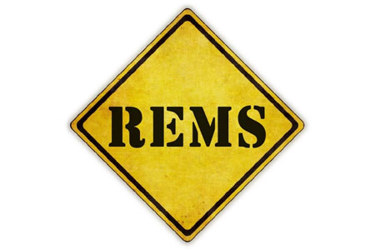Understanding The FDA's Current Focus On Risk Evaluation And Mitigation Strategies
A conversation with Linda Pissott Reig, REMS Industry Consortium

Earlier this year, the FDA asked for comments about how the government handles change requests from drug sponsors with risk evaluation and mitigation strategies (REMS).
More specifically, the agency wanted comments on considerations the Health and Human Services secretary should make when weighing sponsor company requests to change third-party vendors who help implement and manage REMS.
The REMS Industry Consortium (RIC) submitted an extensive comment in response to five inquiries in the agency’s request. The inquiries focused on stakeholder engagement, testing, and quality controls that should go along with a vendor change.
We asked Linda Pissott Reig, an attorney at Buchanan Ingersoll and Rooney serving as RIC legal counsel and strategic advisor, to explain more about why the agency is focusing on safety programs for drugs with high-risk profiles and what it means for drug companies that have REMS products in their portfolios.
Can you give us some quick background on why the FDA is soliciting comments on the REMS program right now?
Reig: The FDA solicitation for comments about REMS comes as a result of a Congressional mandate. REMS impose additional requirements before patients can access certain prescription drugs that may pose significant safety risks for some patients. The overall objective for REMS is safe access to medicines that may provide significant medical benefits.
In December 2022 Congress adopted the FDA Omnibus Reform Act, which requires FDA to solicit feedback about using service providers to administer and implement REMS programs.
There are now 68 separate REMS programs. Multiple manufacturers may be subject to the same REMS program, either because the REMS product is now available as both a brand and a generic or biosimilar, or because the program is applicable to all products within a particular therapeutic class. While some requirements may be similar or even identical among different REMS programs, ultimately, each of these 68 separate REMS programs follows a unique approach for how it manages and mitigates risk.
For many REMS programs, vendors hold significant responsibilities for REMS program execution. While many vendor substitutions have occurred without delays or interruptions in patient access to their prescription medicines, on some occasions, vendor substitutions have posed challenges.
The assessment FDA is now undertaking focuses not only on past experiences but also the current status of REMS and thoughts on future planning. The RIC hopes that the assessment will result in valuable insights to benefit patients and their caregivers in achieving prompt, safe access to prescription medicines that are subject to REMS.
How is this exercise likely to affect companies that use third-party vendors for REMS? Could it potentially make their products more difficult for patients to get or, at the very least, complicate downstream supply chains?
Reig: Patient access is a top priority, and pharmaceutical and biopharmaceutical companies recognize how important it is that patients have ready access to the medicines they rely upon. There have been many successes over the years with service provider transitions, but from time to time delays or interruptions in access to REMS medicines have occurred. Companies can learn from the challenges in vendor substitutions, as well as the many success stories, and this enhanced awareness can help to prevent, or at least significantly mitigate, the risk of delays or disruptions in the future.
When only one drug manufacturer has a product that is subject to a REMS, it may be possible for that one drug manufacturer to host the REMS with that manufacturer’s own internal personnel and resources.
As product exclusivities under patent and FDA law expire and generics or biosimilars enter the marketplace, however, the government prefers that competitors work together to offer a single shared REMS program. Single shared REMS programs can provide a benefit to patients and healthcare providers, who can be directed to one shared REMS program (regardless of which manufacturer’s product is dispensed). While single REMS programs and single shared REMS programs can both be hosted directly by a pharmaceutical or biopharmaceutical company, service providers are regularly engaged to coordinate and lead the effort.
Stated another way, it is quite common for single shared REMS programs to leverage the assistance of REMS service providers for REMS program management. Those service providers serve a valuable role by helping to facilitate (and execute on) collaboration by the various pharmaceutical or biopharmaceutical companies that are all selling a REMS-regulated product.
Ultimately, the ability of a REMS program to achieve its objectives in a seamless manner is not a matter of whether a manufacturer is administering the program directly or whether a service provider is doing it. Indeed, success in REMS program implementation can be, and has been, achieved through either approach. Over time we may see favorable effects if more vendors enter the marketplace that are knowledgeable about the various facets of REMS program management.
Quality management systems and information technology infrastructure are major components of service provider selection, as they are important factors for, for example, building databases and call centers. Should the number of service providers capable of providing REMS services expand, this could allow additional opportunities for REMS program excellence.
What can sponsor companies with REMS products do now to lock up their programs?
Reig: Prescription drugs and biologics can offer significant benefits to patients, but also by their nature may pose safety risks for some patients. For those products with significant potential safety risks, the REMS enables FDA to grant approval of the products because the REMS program mandates the adoption of additional safeguards to mitigate known safety risks.
Ultimately, a REMS program reflects that FDA has determined that the REMS program will enable sufficient mitigation (though not elimination) of significant safety risks. As a result, patients are granted access to utilize a product where, due to the REMS program, the potential benefits are viewed as outweighing the potential risks.
Importantly, patients are fortunate to have access to a medicine that would not be on the market were the REMS program not in place. Quality assurance, service provider accountability, and IT expertise are all factors that will play important roles in REMS program success. The selection and validation of service providers during the development and operations of a REMS program can be a valuable tool in driving reliability and efficiencies.
What, if anything, should biologics manufacturers with REMS products be especially aware of during this exercise?
Reig: Biologics companies, similar to other manufacturers, are able to manage REMS programs directly or to outsource REMS program management. Either way, a commitment to quality standard adherence, including 21 CFR Part 11, is important. In addition, sufficient staffing and a commitment to excellence will be important factors to enable seamless access to prescription drugs that are subject to REMS.
How can technology lessen sponsors' reliance on third-party service providers and thus reduce disruptions?
Reig: As technology evolves, we can expect that there will continue to be advancement in how various systems communicate (including healthcare provider electronic health records, pharmacy records, insurance and pharmacy benefit manager services data, and distributor systems). The ultimate objective is communication among these various systems that occurs in a seamless and efficient manner.
REMS programs are faced with many different electronic records arising from a variety of sources. The level of compatibility among all these diverse sources is not consistent. Over time, and with the continued emergence of advanced technologies that are more nimble and powerful than ever, we should witness the arrival of greater interactivity and compatibility to facilitate more seamless and efficient access to REMS-regulated prescription drugs. We are excited about the opportunities that exist as advanced technologies are leveraged in the REMS space to not only administer and implement REMS programs but also to measure success and reduce patient and healthcare provider burden.
About the RIC: The REMS Industry Consortium (RIC), formally established in September 2021, is a nonprofit organization that seeks to foster collaboration and innovation to advance the objectives of patient safety, appropriate access to medicines and best practices in REMS-related drug and biologic risk management. Current board members are representatives of the six founding companies: Amneal, Bristol Myers Squibb, the Janssen Pharmaceutical Companies of Johnson & Johnson, Jazz Pharmaceuticals, Teva, and Viatris. RIC membership has now expanded to 34 entities comprised of 25 pharmaceutical or biologic companies and nine industry partners. See www.remsconsortium.org for more information.
 About the Expert: Linda Pissott Reig is an attorney and shareholder at Buchanan Ingersoll and Rooney. Ms. Reig advises on all aspects of the research, development, marketing, and sale of pharmaceuticals, medical devices, biologics, dietary supplements, and medical foods. She is a former pharmaceutical product liability litigator and, since 2014, has authored the annual Practising Law Institute’s Pharmaceutical Compliance and Answer Book chapter on risk evaluation and mitigation strategies. In early 2021, six companies engaged Ms. Reig and the Buchanan law firm to serve as legal counsel and strategic partners to formally establish the REMS Industry Consortium and support the consortium’s efforts to achieve its objectives.
About the Expert: Linda Pissott Reig is an attorney and shareholder at Buchanan Ingersoll and Rooney. Ms. Reig advises on all aspects of the research, development, marketing, and sale of pharmaceuticals, medical devices, biologics, dietary supplements, and medical foods. She is a former pharmaceutical product liability litigator and, since 2014, has authored the annual Practising Law Institute’s Pharmaceutical Compliance and Answer Book chapter on risk evaluation and mitigation strategies. In early 2021, six companies engaged Ms. Reig and the Buchanan law firm to serve as legal counsel and strategic partners to formally establish the REMS Industry Consortium and support the consortium’s efforts to achieve its objectives.
